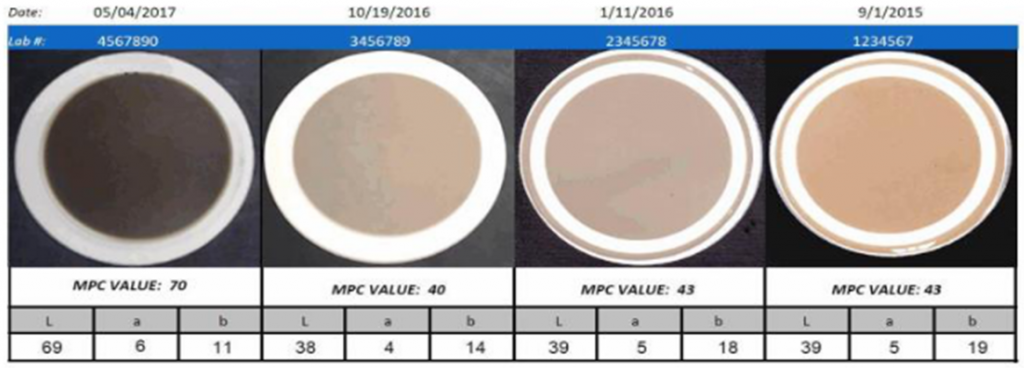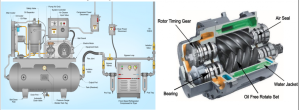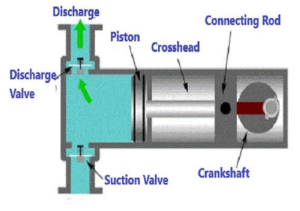Varnish Testing – The MPC Test
In the last issue of our technical bulletin, we discussed the causes and impacts of varnishing on lubrication systems. Lubricating oils, particularly in gas turbines and hydraulic systems, are highly susceptible to the detrimental effects of varnishing. By measuring the level of insolubles present in a lubricant, informed decisions can be made regarding the implementation of varnish removal and mitigation technologies. This can reduce damage to essential equipment and prevent costly downtime. The most common tests for varnish are the MPC, QSA and ultra centrifuge tests. In this issue, we will discuss the MPC test.
Membrane Patch Colorimetry (MPC) – ASTM D7843
The test method
The oil sample is first kept at about 65°C for 24 hours prior to the test and then left for about 72 hours at 20°C. A certain volume of the oil sample is then diluted by a non-polar solvent (such as petroleum benzene) and passed through standard membranes with a 0.45-micron pore size. Depending on the amount of varnish contamination in the oil, the standard white membrane will discolour to varying degrees. The intensity of the colour created on the membrane is measured by a spectrophotometer and a number ranging from 0 to 100 (in rare cases even above 100) will be assigned as an indicator of varnish potential.
Interpretation of MPC Values
The MPC test measures the insoluble material dissolved or suspended in a lubricating oil or hydraulic fluid. The darker the membrane patch, the more insoluble material is present in the oil. It should be noted that the MPC value is not a measure of the amount of varnish already deposited on the machine surfaces. It is generally considered to be an estimate of the potential of the oil to form varnish, however there are specific instances where this may not be true. For example, an oil with a low MPC value can correspond to heavy varnish deposits if thermals stresses are high enough that varnish can be formed and deposited entirely within a localized assembly such as a bearing house.
The most useful information from MPC tests are obtained by trending results. For instance, slowing increasing MPC values will indicate an increased likelihood of varnish formation. A decrease in MPC values without any corrective action performed can indicate that the insoluble products have deposited as varnish in the system.
Apart from the MPC value, L, a and b color values are also reported as part of the MPC test. The L value is a black to white scale. Higher values indicates a higher concentration of black particles, such as soot. The a value is a red to green scale. Higher values could indicate greater potential for sludge buildup, corrosive particles or a reduction in EP additives. The b value is a yellow to blue scale. The higher the b value, the more susceptible the oil is to sticky deposits.

Lubri-Con Ltd. can supply advanced Annual Turbine Oil Analysis using our expert contracted oil laboratories in the USA. Equipped with the latest laboratory and communications technology, we can provide used oil analysis test results for a variety of equipment. Our comprehensive reporting on analytical data assists in the planning of effective maintenance schedules and can provide an early warning of potential operating problems and/or lubrication failure.
Annual Turbine Oil Analysis Test Package
- Color (ASTM D1500)
- Demusibility (ASTM D1401)
- Foam Seq 1 (ASTM D895)
- FTIR (JOAP Method)
- Karl Fischer (ASTM D6304)
- Membrane Patch Colorimetry (MPC)
- Particle Count (ISO 4406-99)
- Rotating Pressure Vessel Oxidation (ASTM D2272)
- Ruler
- Rust (ASTM D665A)
- Spectrochemical Analysis (ASTM D5185)
- Acid Number (ASTM D974)
- Ultra Centrigue
Industrial Basic Test Package
- Spectrometric Analysis
- Viscosity @ 40 degree Celsius or 100 degree Celsius
- Acid Number
- Oxidation & Nitration
Industrial Premium Test Package
- Spectrometric Analysis
- Water by Karl Fisher
- Viscosity @ 40 degree Celsius
- Acid Number
- Particle Count with ISO Cleanliness
- Oxidation & Nitration
Diesel Engine Test Package
- Spectrometric Analysis
- Viscosity @ 100 degree Celsius
- Base Number
- Fuel/Glycol by FTIR
- Oxidation & Nitration





